At an Aug. 2 bicycling event in Kaohsiung, Bai Yue, in his 20s, described one important benefit he’d received from engaging in the activity: a new girlfriend. Bai met the young woman, Tzi Lin, through a folding bike blog, and they began going on dates together to biking events.
Now, the two are a couple. Both attended the Kaohsiung event, where more than 5,000 people turned out to tour two new bicycle paths.
Bai and Lin are among an estimated 600,000 bicycling enthusiasts nationwide, nearly double the 330,000 in 2006, a recent report released by the Council for Economic Planning and Development showed. Bicycle sales have shot up, as Taiwanese flock to enjoy the health and recreational benefits of the sport.
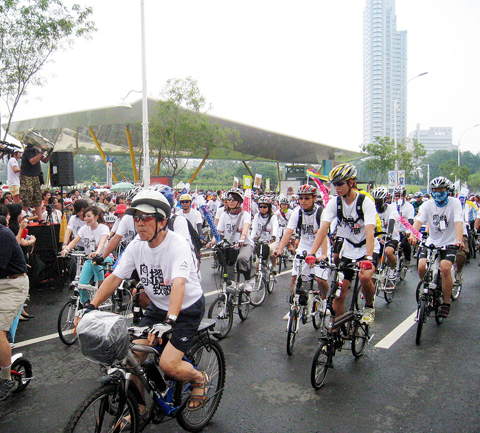
PHOTO: CNA
The fad has gotten a further boost with skyrocketing fuel prices, which have made bicycles an attractive, cheaper option to traveling by car or scooter.
Now, with Taiwan’s love affair with the bicycle in full bloom, cities and counties are scrambling to meet cyclists’ demands for more racks, bike paths and dedicated lanes on city streets. But cyclists say more needs to be done — especially in the area of safety — to make Taiwan a truly bicycle-friendly nation.
In a survey conducted by the Chinese Cultural University earlier in the year, cyclists described bicycles as being a “symbol of freedom, “helping conserve energy, reduce pollution and the number of cars on the road, and promote physical fitness.”
The growing popularity of recreational cycling can be seen in the many bicycle tour events in the past few months — such as Kaohsiung’s folding bike event in May — which now attract hundreds or even thousands of people. A survey released by the Taipei City Government earlier this month showed that the number of city residents who ride bikes increased to 10.5 percent of the population last month, up from 6 percent in May. The city expects that if fuel prices increase another 30 percent, ridership will further rise to 16.5 percent.
Capitalizing on the current bicycle fad, Taiwan’s Giant Inc, the largest domestic bicycle manufacturer, sold 140,000 bikes in Taiwan in the first half of the year, 40 percent more than in the same period last year.
The company’s revenue for the first half of this year soared 60 percent to NT$1 billion (US$32 million) , company spokeswoman Irene Chen (陳美惠) said.
She said that Giant expects the number of cyclists to continue growing, hitting some 700,000 by the end of the year.
Governments are trying to keep up with the challenges presented by the surging number of bicyclists demanding better facilities and rights. The central government announced a plan on Aug. 7 to add more dedicated lanes alongside major city streets nationwide to better meet cyclists’ needs.
The plan has already sparked complaints from motorcyclists, who already dodge cars, trucks and buses in heavy traffic on roads like Taipei City’s Dunhua Road.
Chen Chin-pi, 45, a white-collar employee who commutes daily by scooter from Zhonghe (中和) to his office in downtown Taipei, said there are more motorcyclists than bicyclists in the country, and that the government should protect motorcyclists’ rights, too.
Chen suggested that the government develop more bike routes rather than adding bike paths, which will take away space from already-crowded traffic lanes.
The controversial bike-lane plan comes after local governments have already added hundreds of kilometers of new bicycle trails, and thousands of new bicycle racks.
By the end of last year, the central government had built 40 dedicated bicycle paths totaling more than 1,180km. It hopes to build a total of 2,600km of paths by 2011.
Taipei City and Taipei County now have more than 500km of dedicated bike paths. Taipei City provides 16,000 racks for parking bicycles, including 1,100 double-decker racks outside MRT stations. The city hopes to add bike parking with lockers to further help cyclists.
Kaohsiung City now has more than 100km of bike trails, and hopes to have a total of 180km built before the opening of the World Games in Kaohsiung next summer.
With the cycling boom, concerns about more accidents have emerged.
A survey commissioned by the Department of Health showed that every year sees an average of 3,700 injuries from cyclists, with 3 percent to 5 percent of them fatal.
It’s not yet clear to what extent such mishaps are on the rise with the nationwide fad, but Tainan City statistics showed bicycle accidents there spiking 24.4 percent in the first half of this year as compared with the same period last year.
The health department survey showed that the main cause of accidents was cyclist error, chiefly not yielding right-of-way to motorists or disobeying other traffic rules. Poor road design and bad visibility at night were also cited as main causes.
To keep accident numbers down, cyclists suggested in a recent interview that the government create more dedicated bike lanes, as are already planned in Taipei, Kaohsiung and Taichung.
David Reid, in his 30s, a cycling enthusiast and Taipei County resident, said there are plenty of recreational bicycle paths outside city centers, but that doesn’t solve the problems many city commuters face. The government should enact policies to reduce cars on the road, he said, but did not give details.
However, Chang Ming-yuan, a 42-year-old cyclist, said the goal could be reached by pushing forward car-sharing schemes — sharing a ride with a colleague at work or rotating with other parents on school runs — or designating a national car-free day.
Some cyclists also suggested that the government require all bicycles sold in Taiwan to meet higher safety requirements — for example, by requiring that all bicycles have both front and rear reflectors. They also advised the government to better enforce traffic rules and promote awareness of proper road use among cyclists.
For example, all cyclists are supposed to ride the same direction as traffic, and use hand signals to indicate when they are slowing, stopping or turning.
Cyclists also emphasized that all riders should wear helmets, to prevent sometimes fatal head injuries resulting from bicycle accidents.
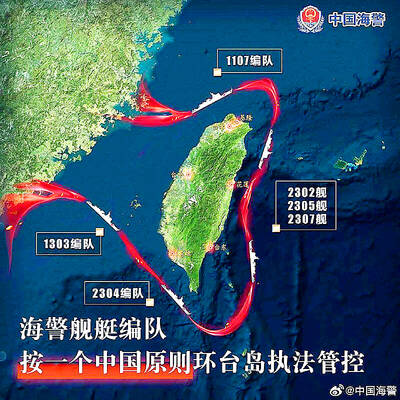
Taiwan would benefit from more integrated military strategies and deployments if the US and its allies treat the East China Sea, the Taiwan Strait and the South China Sea as a “single theater of operations,” a Taiwanese military expert said yesterday. Shen Ming-shih (沈明室), a researcher at the Institute for National Defense and Security Research, said he made the assessment after two Japanese military experts warned of emerging threats from China based on a drill conducted this month by the Chinese People’s Liberation Army’s (PLA) Eastern Theater Command. Japan Institute for National Fundamentals researcher Maki Nakagawa said the drill differed from the
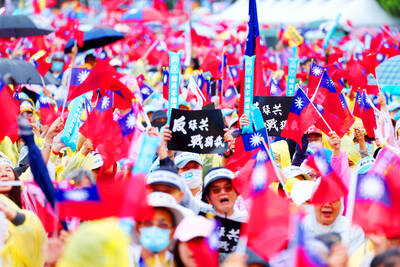
‘WORSE THAN COMMUNISTS’: President William Lai has cracked down on his political enemies and has attempted to exterminate all opposition forces, the chairman said The legislature would motion for a presidential recall after May 20, Chinese Nationalist Party (KMT) Chairman Eric Chu (朱立倫) said yesterday at a protest themed “against green communists and dictatorship” in Taipei. Taiwan is supposed to be a peaceful homeland where people are united, but President William Lai (賴清德) has been polarizing and tearing apart society since his inauguration, Chu said. Lai must show his commitment to his job, otherwise a referendum could be initiated to recall him, he said. Democracy means the rule of the people, not the rule of the Democratic Progressive Party (DPP), but Lai has failed to fulfill his
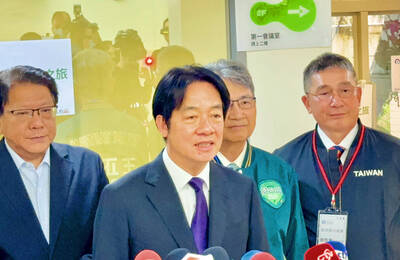
A rally held by opposition parties yesterday demonstrates that Taiwan is a democratic country, President William Lai (賴清德) said yesterday, adding that if opposition parties really want to fight dictatorship, they should fight it on Tiananmen Square in Beijing. The Chinese Nationalist Party (KMT) held a protest with the theme “against green communists and dictatorship,” and was joined by the Taiwan People’s Party. Lai said the opposition parties are against what they called the “green communists,” but do not fight against the “Chinese communists,” adding that if they really want to fight dictatorship, they should go to the right place and face
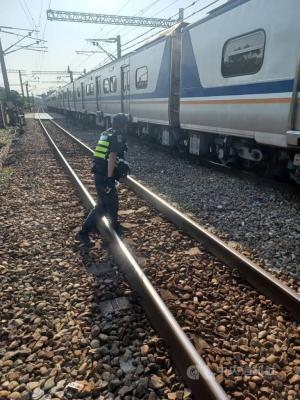
A 79-year-old woman died today after being struck by a train at a level crossing in Taoyuan, police said. The woman, identified by her surname Wang (王), crossed the tracks even though the barriers were down in Jhongli District’s (中壢) Neili (內壢) area, the Taoyuan Branch of the Railway Police Bureau said. Surveillance footage showed that the railway barriers were lowered when Wang entered the crossing, but why she ventured onto the track remains under investigation, the police said. Police said they received a report of an incident at 6:41am involving local train No. 2133 that was heading from Keelung to Chiayi City. Investigators